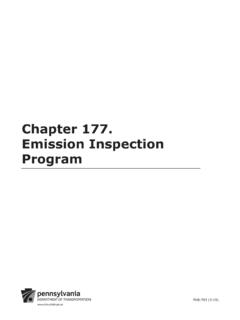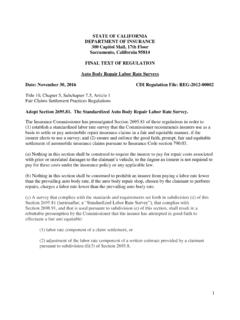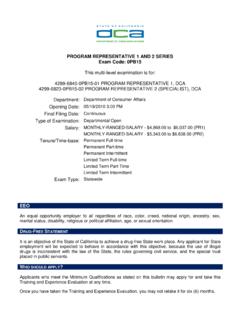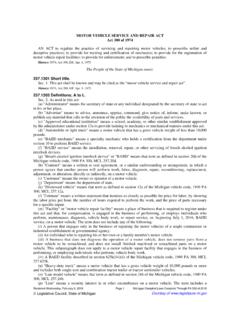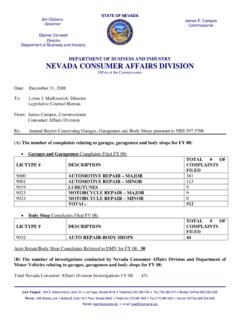Transcription of Occupational Injuries, Illnesses, and Fatalities to ...
1 bureau OF labor STATISTICSCOMPENSATION AND WORKING CONDITIONSPage 1 Occupational injuries , illnesses , and Fatalities to automotive Service Technicians and Mechanics, 2003 to 2005by Sean M. SmithBureau of labor StatisticsOriginally Posted: May 23, 2007 Mechanics are more likely than the average worker to be injured or killed on the job, as evidenced by higher rates of Fatalities and injuries and illnesses . For both fatal and nonfatal injuries , contact with objects and equipment, such as parts and materials and vehicles, represents a significant hazard. Many of the remaining nonfatal cases are due to overexertion and sprains and strains; assaults and violent acts are a leading cause of workplace 2005, there were 954,000 automotive service technicians and mechanics (henceforth to be referred to as "mechanics") employed in the United Mechanics are responsible for keeping the Nation's more than 135 million automobiles in running As vehicle components have become more complex and computerized, the job of a mechanic has increasingly become a high technology Mechanics have often specialized in a specific type of automotive repair, becoming experts in engine, transmission, brake, front end, or air-conditioning repair.
2 More than 290,000 mechanics are ASE certified, a nationally recognized certification program that tests a mechanic's knowledge every 5 2003 to 2005, 147 mechanics were killed on the Their fatality rate was per 100,000 employed in 2005, which was higher than the rate of per 100,000 employed for all occupations combined. (See table 1.) There were 15,680 nonfatal injuries and illnesses to mechanics involving days away from work in 2005, about the same as in 2004, following a decline of percent from 2003 to 2004. Among all occupations, mechanics ranked 14th in terms of the number of injuries and illnesses involving days away from work in 2005, the same as in 2004.
3 (Mechanics ranked 13th in 2003.) The median number of days away from work for injured or ill mechanics in 2005 was 5 days, less than the median of 7 days for all , mechanics worked in automotive repair and maintenance shops ( percent) or for automobile dealers ( percent); percent worked for parts, accessories, and tire 2005, percent of the mechanics who incurred a nonfatal injury or illness involving days away from work were employed by automobile dealers, percent worked for automotive repair and maintenance establishments, and percent were employed by automotive parts, accessories, and tire stores. A small number were employed in goods-producing industries such as manufacturing ( percent) and construction ( percent).
4 Of the 147 fatal incidents that took place from 2003 to 2005, percent occurred in the automotive repair and maintenance industry, and percent occurred in automobile dealerships. All were employed in private CharacteristicsAll of the mechanics who were fatally injured over the 2003-05 period were men. Similarly, the vast majority (more than 95 percent) of mechanics who were nonfatally injured during the period were men. More than two-thirds ( percent) of the fatally injured mechanics were wage and salary workers, and nearly a third ( percent) were 4 in 5 of the nonfatally injured mechanics in 2005 were non-Hispanic whites, percent were Hispanics, and percent were non-Hispanic Similar to the nonfatally injured mechanics, non-Hispanic whites made up percent of the Fatalities in this occupation from 2003 to 2005.
5 Hispanics accounted for percent of Fatalities --less than their share of employment in this occupation ( percent). Non-Hispanic blacks represented percent of employment among mechanics, but they suffered percent of the bureau OF labor STATISTICSCOMPENSATION AND WORKING CONDITIONSPage 2 Circumstances Of The injuries , illnesses , And FatalitiesNonfatal injuries and illnesses . As can be seen in chart 1, most of the injuries and illnesses to mechanics in 2005 were due to contact with object or equipment ( percent) or to overexertion ( percent). Contact with object includes being struck by an object ( percent of the total), struck against an object ( percent), and caught in an object, equipment, or material ( percent).
6 For injuries and illnesses involving contact with object and equipment, percent involved vehicles, percent involved hand tools, nonpowered, and percent involved engine parts. (See table 2.) injuries that were due to the worker being struck by an object accounted for percent of the injuries and illnesses to mechanics, but only percent of injuries and illnesses to all occupations. For overexertion injuries , percent involved tires and wheels, and percent involved engine parts and accessories. More than half ( percent) of the overexertion injuries were due to overexertion in lifting source of injury or illness is the object, substance, exposure, or bodily motion that directly produced or inflicted the disabling condition.
7 The leading source of injury or illness to mechanics in 2005 was parts and materials ( percent), followed by vehicles ( percent); the comparable rates for all occupations were percent and percent, respectively. For injuries involving vehicles, percent were due to transportation accidents, and percent were due to contact with objects and equipment, such as being struck against a stationary object ( percent), caught in or compressed by equipment or object ( percent), and struck by an object ( percent).The nature of injury or illness names the principal physical characteristic of a disabling condition. The leading nature of injury or illness to mechanics in 2005 was sprains and strains ( percent), which was less than the comparable rate for all occupations ( percent).
8 Sprains were followed by cuts, lacerations, and punctures ( percent), which was higher than the rate for all occupations. Bruises and contusions accounted for percent of the injuries to to the upper extremities accounted for percent of injuries and illnesses to mechanics in 2005, followed by percent to the trunk and percent to lower extremities. Trunk injuries include injuries to the back, which accounted for percent of all injuries to mechanics. Eye injuries accounted for percent of injuries to mechanics, compared with just percent among all days with the largest number of nonfatal injuries and illnesses to mechanics in 2005 were Thursday and Tuesday, with 3,250 and 3,160 cases respectively.
9 The day with the fewest injuries was Sunday (680), followed by Saturday (1,110). Fatalities . Assaults and violent acts accounted for percent of the workplace Fatalities among mechanics during the 2003-05 period, compared with percent among all occupations. Of these, percent were homicides and percent were self-inflicted wounds. (See chart 2.) Self-inflicted Fatalities represented percent of all Fatalities to mechanics, but only percent of Fatalities to all workers. Nearly half ( percent) of the self-inflicted Fatalities were by self-employed mechanics, although only 16 percent of mechanics are self-employed. Gunshot wounds accounted for percent of the Fatalities to mechanics, compared with percent for all leading event or exposure for workplace Fatalities during the 2003-05 period was contact with objects and equipment ( percent); the comparable figure for all occupations was percent.
10 The leading sources of Fatalities were vehicles ( percent), bullets ( percent), and parts and materials ( percent). Among the 66 cases with vehicles as the source of the fatality, percent were transportation incidents and percent were from being struck by falling objects, such as a car falling off a lift, rack, or jack. Asphyxiations and suffocations accounted for percent of the Fatalities to mechanics during the are more likely than the average worker to be injured or killed on the job, as evidenced by higher rates of Fatalities and injuries and illnesses . For both fatal and nonfatal injuries , contact with objects and equipment, such as parts and bureau OF labor STATISTICSCOMPENSATION AND WORKING CONDITIONSPage 3materials and vehicles, represents a significant hazard.












